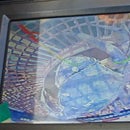Introduction: CrabCam Part One: Overview and Camera Construction
We have a cottage on the water. Part of the cottage life is enjoying the bounties of the sea: putting out crab and prawn traps. But that can be hard work - and sometimes for very little or no reward. It requires rowing out in all weather pulling up eighty or more feet (in the case of prawn traps), to find either undersized crabs or worse.... nothing! I began to wonder if there might be a better way.
I had noticed that some people had put GoCams in traps and getting spectacular results; but really wouldn't solve my problem, as you had to pull up the trap to get the camera. I wanted something that would show me what was happening in the trap - live! From the comfort of my easy chair in the cabin.
I searched online and could find nothing that filled the bill, so with the help of my son I set out to make something that would fill the bill. It wasn't as easy as it sounds; but after three years I finally have a fully functioning crabcam.
Supplies
All items were found on ebay unless otherwise stated:
CAMERA
- 8 LED Car 170° Rear View Backup Parking Camera Night Vision Waterproof HD CMOS $ 3.25
- Camera Protective Case Shockproof box Waterproof Case for SJ4000 Sports Camera $ 4.08
- 30M 100FT CCTV Camera DVR Video DC Power Security BNC RCA $ 12.50
- Waterproof Car plug connector with wire 18AWG terminal 4 connectors $ 1.74
- Silicon glue
- Marine grade two part epoxy glue
Step 1: Choosing the Camera
Of course the first thing you need, besides a crab trap, is a camera. You could try and source an underwater cctv unit such as a fishing camera, but you're looking at around hundred dollars or more, and that's for one that probably only has about 15 meters of line. So I opted to build my own for about $20.00. I sourced some Rear view Backup Camera Night Vision cameras on ebay. There are lots to choose from. Some have LED lights, which might be useful in murky water even though it might be more of a drain on the batteries.
Step 2: Choosing the Waterproof Case
Although the camera advertisement says it's waterproof, I don't think it meant for submersion in the ocean so a waterproof case would be necessary. Again, I found something on ebay. A Waterproof Case for SJ4000 Sports camera only $4.00.
Step 3: Inserting Cable Into Watertight Case
You need to get the cable into the watertight case. I found that the simplest way is through the shutter on topof the case. There is a lock washer holding the spring on the inside of the case. Remove the lock washer and the shutter will easily come out. You will have to slightly enlarge the hole to get the cable to fit the cable through. Snip one of the cabe above where the yellow (video) and red (power) connectors join. Don't glue it in until you have the camera installed. You'll see there is a white wire (video), red wire(DC positive) and a shielded bare cable (ground).
Step 4: Wiring the Camera Cable.
This is a fairly labor intensive step. First the distance between the camera and step down converter (the black bulge) is way too long. You've got to take a piece out of it and shorten it to about 3 or 4 inches so it will fit into the camera case without a lot of loose cord. Then snip the red and yellow connectors off. You may have to shorten these cords a bit so everything fits neatly into the camera case. Make sure you slide the heat shrinks on before you solder the wires: from the yellow connector to the video(white) of the cable. The red goes to the red of the cable, and finally connect the grounds. At this point it's a good idea to check that the camera is working. If it is, the next step is to carefully glue the camera into the case. I usually put a weight on it and let it sit for a few hours to a day. then I put a bead of silicon around it. Finally arrange the cables inside the case and slide out as much excess cord out of the case and apply silicon glue on the inside where the cable goes out of the case and the outside as well. You really want to make sure it's water tight and secure and can't pull out.
That completes the camera part of the crabcam.
Step 5: Wiring the Connector on the Buoy End.
Now that wiring is done at the camera end, we have to place the connector on the other end of the cable that connects to the transmitter in the buoy. Snip the connectors off the cable. I'm using a male 4 wire waterproof connector that will attach to the one coming out of the buoy.
My wiring is as follows:
On the Waterproof connector: connect red to red on cable
On the Waterproof connector: connect green to white on cable
On the Waterproof connector: connect the black and brown wires to ground shield
The wires are THIN. so make sure you use lots of heat shrink. I did that for individual wires, then a larger piece for the cable itself, and reinforced it with tape. These connections are weak points and take as much care to strengthen them.
NEXT: THE TRANSMITTING UNIT











